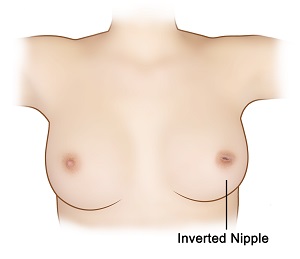
What are Inverted Nipples?
Inverted nipples, also known as retracted nipples, is a medical condition in which one or both nipples turn inward or lie flat against the areola (the darker circular area of skin around the nipple), instead of pointing outward or sticking out. The condition can be permanent, in which the nipples are completely retracted inwards, or temporary. The condition can be graded based on the reversibility of the inversion – grade 1 inverted nipples can be turned out with cold or massage, grade 2 is more difficult to turn out, soon falling back into the inverted state, while grade 3 inverted nipples remain permanently inverted.
Causes of Inverted Nipples
Inverted nipples can occur due to congenital abnormality in some women, whereas in other cases, it may occur as a result of trauma or disease. Any medical condition that causes scarring or inflammation of tissues at the back of the nipple may trigger the inward pulling of the nipple. Some of the other causes of inverted nipples include:
- Ageing
- Infection
- Breast cyst
- Benign breast tumours
- Mastitis
- Genetics
- Fibroadenoma
- Breast duct ectasia
- Carcinoma
- Paget’s disease of the breast
- Breast surgery complications
Signs and Symptoms of Inverted Nipples
In addition to retracted nipples, other signs and symptoms of inverted nipples are linked to its causes and may include the following:
- Pain, tenderness, or discomfort
- Swelling or lump of the nipple
- Thickening or dimpling of the skin
- Redness, irritation, or oozing
- Abnormal nipple discharge
- Flaky, itchy, and dry skin
Diagnosis of Inverted Nipples
In order to diagnose inverted nipples, your doctor may perform the following:
- A review of your medical history to check for any previous history of breast conditions
- A clinical breast examination to check for any lumps and other problems, such as nipple discharge or changes in the appearance of the breasts
- Mammogram – an X-ray examination of the breast to check for subtle changes not detected during a physical exam
- Ultrasound scan – use of high-frequency sound waves to create pictures of breast tissue for detailed examination
- Fine-needle aspiration – use of fine needle and syringe to aspirate cell samples from the infected area for microscopic analysis
- Core biopsy – use of a needle to extract a sample of breast tissue from a suspicious area for microscopic analysis if cancer is suspected
Treatment for Inverted Nipples
Some of the treatment methods that can help treat inverted nipples include:
- Hoffman technique: manual exercises using your thumb to loosen any adhesions at the base of the nipple that keep it inverted
- Suction devices: This method employs non-invasive ways to draw out the nipples. Some of the common suction devices used in this method include:
- Breast pumps: This is usually used immediately before breastfeeding to draw out the nipple.
- Evert-it™ Nipple Enhancer: Consists of a syringe with a soft flexible silicone tip. Like breast pumps, it is used before breastfeeding to protrude out the nipple through suction.
- Niplette: This gently draws the nipple into a small plastic cup with the help of suction. It is worn for about eight hours and provides a permanent solution.
- Breast shells: Tiny cups with a hole in the centre worn over the breasts to draw out inverted nipples.
- Piercings: In this method, a nipple piercing is done to draw out inverted nipples to keep the nipple in an upright stance.
- Surgery: Inverted nipple correction surgery is employed if you are looking for a permanent solution and is usually recommended for grades 2 and 3 cases of inverted nipples. The surgery is performed on an outpatient basis under local or general anaesthesia. Your surgeon makes a small incision either within or around the areola, and lifts the nipple, supporting it with a splint, or surgically releases or divides the milk ducts that are pulling the nipple inward. The incision is then closed with stitches.
Each method comes with its advantages and disadvantages. Your doctor will weigh the pros and cons of the procedure and help you decide on the best method suited for you.
